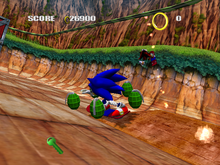Sonic Team is a video game developer owned by the Japanese video game company Sega as part of its Sega CS Research and Development No. 2 division. Sonic Team is best known for the long-running Sonic the Hedgehog series and games such as Nights into Dreams and Phantasy Star Online.
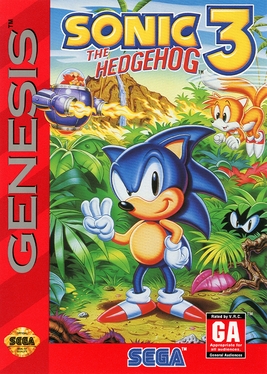
Sonic the Hedgehog 3 is a 1994 platform game developed and published by Sega for the Genesis. Like previous Sonic games, players traverse side-scrolling levels while collecting rings and defeating enemies. They control Sonic and Tails, who attempt to retrieve the Chaos Emeralds to stop the evil Doctor Robotnik from relaunching his space station, the Death Egg, after it crash-lands on a mysterious floating island. Sonic 3 introduces Knuckles the Echidna, the island guardian, who lays traps for Sonic and Tails.

Sonic Adventure is a 1998 platform game developed by Sonic Team and published by Sega for the Dreamcast. It was the first main Sonic the Hedgehog game to feature 3D gameplay. It follows Sonic the Hedgehog, Miles "Tails" Prower, Knuckles the Echidna, Amy Rose, Big the Cat, and E-102 Gamma in their quests to collect the Chaos Emeralds and stop Doctor Robotnik from unleashing Chaos, an ancient evil. Controlling one of the six characters—each with their own abilities—players complete levels to progress the story. Sonic Adventure retains many elements from prior Sonic games, such as power-ups and the ring-based health system. Players can play minigames such as racing and interact with Chao, a virtual pet.

Sonic Heroes is a 2003 3D platform game developed by Sonic Team USA and published by Sega as part of the Sonic the Hedgehog series. The player races a team of series characters through levels to amass rings, defeat robots, and collect the seven Chaos Emeralds needed to defeat Doctor Eggman. Within each level, the player switches between the team's three characters, who each have unique abilities, to overcome obstacles. Sonic Heroes abandons the action-adventure and exploration-based gameplay of its predecessors Sonic Adventure (1998) and Sonic Adventure 2 (2001) and instead returns to the linear style of Sega Genesis-era Sonic games.

Sonic the Hedgehog is a 1991 platform game developed by Sonic Team and published by Sega for the Sega Genesis/Mega Drive. The first game in the Sonic the Hedgehog franchise, it was released in North America on June 23 and in PAL regions and Japan the following month. Players control Sonic the Hedgehog, who can run at supersonic speeds; Sonic sets out on a quest to defeat Dr. Robotnik, a scientist who has imprisoned animals in robots and seeks the powerful Chaos Emeralds. The gameplay involves collecting rings as a form of health, and a simple control scheme, with jumping and attacking controlled by a single button.

Yuji Naka, credited in some games as YU2, is a Japanese video game programmer, designer and producer. He is the co-creator of the Sonic the Hedgehog series and was the president of the Sonic Team department until his departure from Sega in 2006.

Sonic & Knuckles is a 1994 platform game developed and published by Sega. Players control Sonic the Hedgehog and Knuckles the Echidna in their quests to save Angel Island; Sonic tries to stop Doctor Robotnik from re-launching his orbital weapon, the Death Egg, while Knuckles scuffles with Robotnik's minion, EggRobo. Like previous Sonic games, players traverse side-scrolling levels at high speeds while collecting rings and defeating enemies.

Knuckles' Chaotix is a 1995 platform game developed by Sega for the 32X. A spin-off from the Sonic the Hedgehog series, it features Knuckles the Echidna and four other characters known as the Chaotix, who must prevent Doctor Robotnik and Metal Sonic from obtaining six magic rings and conquering a mysterious island. Gameplay is similar to previous Sonic games: players complete levels while collecting rings and defeating enemies. Knuckles' Chaotix introduces a partner system whereby the player is connected to another character via a tether; the tether behaves like a rubber band and must be used to maneuver the characters.
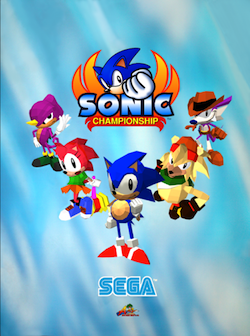
Sonic the Fighters, also known as Sonic Championship on arcade versions outside Japan, is a fighting game developed by Sega AM2. First released in 1996 in arcades on Sega's Model 2 arcade system, Sonic the Fighters pits players in one-on-one battles with a roster of characters from the Sonic the Hedgehog series.

Sonic Jam is a video game compilation developed by Sonic Team and published by Sega for the Sega Saturn. It was released in Japan in June 1997 and in North America and Europe the following August. It contains the four main Sonic the Hedgehog games released on the Sega Genesis: Sonic the Hedgehog (1991), Sonic the Hedgehog 2 (1992), Sonic the Hedgehog 3 (1994) and Sonic & Knuckles (1994). It also features a 3D environment, "Sonic World", which doubles as an interactive museum of Sonic the Hedgehog content.
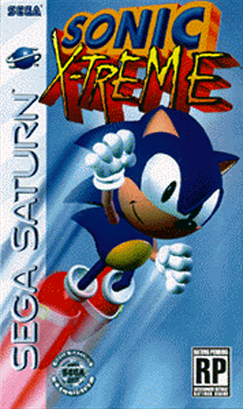
Sonic X-treme was a platform game developed by Sega Technical Institute from 1994 until its cancellation in 1996. It was planned as the first fully 3D Sonic the Hedgehog game, taking Sonic into the 3D era of video games, and the first original Sonic game for the Sega Saturn. The storyline followed Sonic on his journey to stop Dr. Robotnik from stealing six magic rings from Tiara Boobowski and her father. X-treme featured open levels rotating around a fixed center of gravity and, like previous Sonic games, featured collectible rings and fast-paced gameplay.

Shadow the Hedgehog is a 2005 platform game developed by Sega Studios USA and published by Sega as part of the Sonic the Hedgehog series. The game follows Shadow the Hedgehog, a creation of Doctor Eggman's grandfather, Prof. Gerald Robotnik with the aid of Black Doom, as he attempts to learn about his past while suffering from amnesia. Shadow the Hedgehog reintroduces third-person shooter elements from Sonic Adventure 1 and Sonic Adventure 2 but greatly expands on the concept and newly introduces nonlinear gameplay to the Sonic franchise. To defeat enemies, Shadow can use a variety of weapons from each faction and use the newly introduced Chaos powers to aid him in his quest. Out of the twenty-two levels there are eleven that have three possible missions that the player may choose to complete, the other eleven have two missions. The missions completed determine the game's plot and subsequently playable levels.

SegaSonic the Hedgehog is a 1993 arcade game in the Sonic the Hedgehog series by Sega. Controlling Sonic the Hedgehog and his friends Mighty the Armadillo and Ray the Flying Squirrel, the player must escape an island as quickly as possible after they are kidnapped by series antagonist Doctor Eggman. The game is presented from an isometric perspective and players use a trackball to move the characters while dodging obstacles and collecting rings. The game was developed by Sega's arcade division, Sega AM3; it is one of four Sonic games to bear the SegaSonic name and was inspired by the 1984 game Marble Madness.
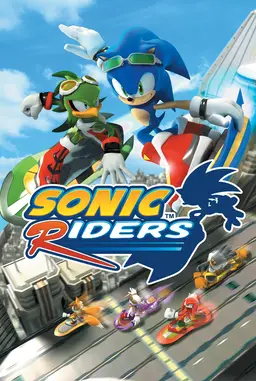
Sonic Riders is a 2006 racing video game for the GameCube, PlayStation 2, and Xbox in which the player controls characters from the Sonic the Hedgehog series on hoverboards. In the game's 16 tracks, the player competes against characters—either controlled by computers or other players—in story and battle modes. It was developed by Sonic Team and Now Production, published by Sega, and released in February 2006 in Japan and North America. It was released in Europe the following month and for Windows at the end of the year. A Game Boy Advance version developed by Backbone Entertainment was canceled.

Sonic the Hedgehog is a 2006 platform game developed by Sonic Team and published by Sega. It was produced in commemoration of the Sonic series' 15th anniversary, and intended as a reboot for the seventh-generation video game consoles. Players control Sonic, Shadow, and the new character Silver, who battle Solaris, an ancient evil pursued by Doctor Eggman. Each playable character has his own campaign and abilities, and must complete levels, explore hub worlds and fight bosses to advance the story. In multiplayer modes, players can work cooperatively to collect Chaos Emeralds or race to the end of a level.

Sonic the Hedgehog is a Japanese video game series and media franchise created by Yuji Naka, Naoto Ohshima, and Hirokazu Yasuhara for Sega. The franchise follows Sonic, an anthropomorphic blue hedgehog who battles the evil Doctor Eggman, a mad scientist. The main Sonic the Hedgehog games are platformers mostly developed by Sonic Team; other games, developed by various studios, include spin-offs in the racing, fighting, party and sports genres. The franchise also incorporates printed media, animations, feature films, and merchandise.

Sonic the Hedgehog 2 is a 1992 platform game developed by Sega Technical Institute (STI) for the Sega Genesis. It follows Sonic as he attempts to stop Doctor Robotnik from stealing the Chaos Emeralds to power his space station. Like the first Sonic the Hedgehog (1991), players traverse side-scrolling levels at high speeds while collecting rings, defeating enemies, and fighting bosses. Sonic 2 introduces Sonic's sidekick Miles "Tails" Prower and features faster gameplay, larger levels, a multiplayer mode, and special stages featuring pre-rendered 3D graphics.

Sonic Origins is a 2022 video game compilation. It features remasters of the first four platform games in Sega's Sonic the Hedgehog series—Sonic the Hedgehog (1991), Sonic the Hedgehog 2 (1992), Sonic CD (1993), and Sonic the Hedgehog 3 & Knuckles (1994)—originally released for the Sega Genesis and the Sega CD. The games are playable in their original format and a new widescreen format that removes lives. Origins adds additional game modes and missions, which allow players to unlock content in a museum.

